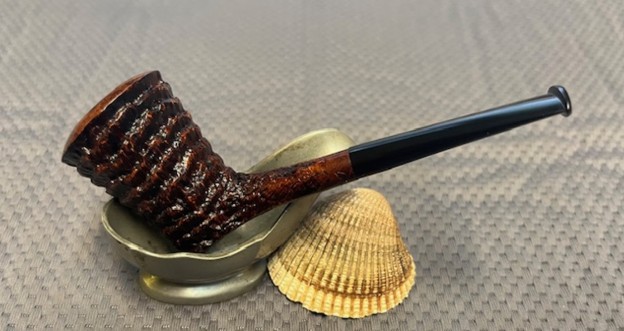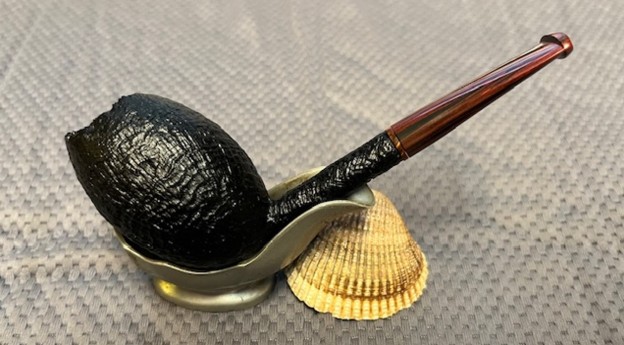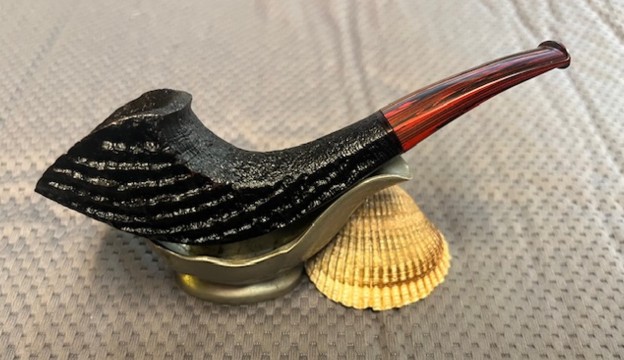Blog by Steve Laug
I fired up my first bowl of tobacco in my UNSMOKED Hand Carved Dominik Kobryń Pencil Shank Dublin this weekend. I rubbed out some Seattle Pipe Club Christmas Spirit Plug. The pipe is stunning and feels great in my hand. The beautiful ring blast gives the pipe a very light weight and very tactile sense that will only be more when it heats up during a smoke. The pencil shank pipe is a dainty 5 inches long and 2 inches tall. It weighs in under 1 ounce at .95 ounces or 27 grams. I have included a few photos of the pipe before I loaded it up and smoked it.
 If Dominik pipes are new to you I am including what I learned when I worked on the first pipe of this brand. When I started I knew nothing about the carver other than he did beautiful work so I turned to Pipedia to see what I could find (https://pipedia.org/wiki/Dominik_Pipes). There was a listing for Dominik Pipes. He is a Polish Carver and I have included the short article in its entirety below.
If Dominik pipes are new to you I am including what I learned when I worked on the first pipe of this brand. When I started I knew nothing about the carver other than he did beautiful work so I turned to Pipedia to see what I could find (https://pipedia.org/wiki/Dominik_Pipes). There was a listing for Dominik Pipes. He is a Polish Carver and I have included the short article in its entirety below.
Dominik pipes are made by Dominik Kobryń. His journey with pipes began in 1993 at a flea market, where he bought his first pipe. From that time his collection has grown a lot. He made his first pipe in December 2016. Dominik credits Wojtek Pastuch as his mentor, and is very grateful for that!
Dominik uses briar from Mimmo Romeo. He makes his stems by hand, mainly from Ebonite and Cumberland rods, but occasionally acrylic. He focuses on unique pipes that are well done technically.
From there I clicked on a link at the bottom of the page that took me to his Pipe sales website (http://www.dominikpipes.com/). Interestingly the site contained almost word for word the information that I had found on Pipedia.
My name is Dominik Kobryń. My journey with pipes began in 1993 on a flea market, where I bought my first pipe. From that time my collection has grown a lot.
I made my first pipe in December 2016. Wojtek Pastuch has taught me a lot about pipemaking and I am very grateful for that!
I use briar from Domenico Romero (Mimmo). I make stems by hand, mainly from ebonite rods and Cumberland, sporadically acrylic. I pay much attention to create unique pipes, well done technically.
 The tobacco I chose for the inaugural smoke is a limited-edition version of Seattle Pipe Club’s Plum Pudding pipe tobacco called Christmas Spirit. I love the Plum Pudding tobacco so when this tobacco was released I got a hold of a tin of Christmas Spirit 2023. The tobacco had been cured with Apple Brandy and there was a cut piece of the wooden Brandy barrel in the tin. It is described by the sellers as a holiday mixture perfect for the season even though I am smoking it out of season. It builds upon a foundation of Plum Pudding Special Reserve — complete with mature Orientals, Latakia, Virginias, Perique, and Black Cavendish —and is aged in apple brandy barrels.
The tobacco I chose for the inaugural smoke is a limited-edition version of Seattle Pipe Club’s Plum Pudding pipe tobacco called Christmas Spirit. I love the Plum Pudding tobacco so when this tobacco was released I got a hold of a tin of Christmas Spirit 2023. The tobacco had been cured with Apple Brandy and there was a cut piece of the wooden Brandy barrel in the tin. It is described by the sellers as a holiday mixture perfect for the season even though I am smoking it out of season. It builds upon a foundation of Plum Pudding Special Reserve — complete with mature Orientals, Latakia, Virginias, Perique, and Black Cavendish —and is aged in apple brandy barrels.  I cut a chunk off the plug and rubbed out a bowl worth of the tobacco. It smelled divine and my mouth watered in expectation. I pressed the tobacco into the bowl leaving it slightly springy so air can be drawn through the tobacco. I did the first light with my lighter to singe the surface of the tobacco. I followed that with the second light to. The draught on the stem was perfect so I drew on the stem and pulled the smoke through the stem and into my mouth. The smoking of the pipe was effortless and once it was lit it burned evenly through the bowl. I enjoyed a flavourful smoke that was very good for a first bowl. The bowl coating that had been used did not affect the flavour or diminish it at all. It was a great smoke.
I cut a chunk off the plug and rubbed out a bowl worth of the tobacco. It smelled divine and my mouth watered in expectation. I pressed the tobacco into the bowl leaving it slightly springy so air can be drawn through the tobacco. I did the first light with my lighter to singe the surface of the tobacco. I followed that with the second light to. The draught on the stem was perfect so I drew on the stem and pulled the smoke through the stem and into my mouth. The smoking of the pipe was effortless and once it was lit it burned evenly through the bowl. I enjoyed a flavourful smoke that was very good for a first bowl. The bowl coating that had been used did not affect the flavour or diminish it at all. It was a great smoke. I took the loaded pipe up to my front porch and sat on chair there and enjoyed the amazing taste of a new to me tobacco. The draught on the pipe was flawless and the sandblast ring grain made the bowl a very cool smoking pipe even as it worked down the bowl.
I took the loaded pipe up to my front porch and sat on chair there and enjoyed the amazing taste of a new to me tobacco. The draught on the pipe was flawless and the sandblast ring grain made the bowl a very cool smoking pipe even as it worked down the bowl.
 The smoke lasted most of an hour and I enjoyed the relaxing ambience of the front porch, above the passersby on the sidewalk below. It is a great pipe and one that I will smoke again and again. If you have not looked at them on the Polish Pipe Makers Section of the rebornpipes store you should take a look there are some real beauties available there. You might find one that delivers the kind of smoke you would enjoy. Thanks.
The smoke lasted most of an hour and I enjoyed the relaxing ambience of the front porch, above the passersby on the sidewalk below. It is a great pipe and one that I will smoke again and again. If you have not looked at them on the Polish Pipe Makers Section of the rebornpipes store you should take a look there are some real beauties available there. You might find one that delivers the kind of smoke you would enjoy. Thanks.















































































































































































































































